Most Famous Indonesian Cuisine
Rice is the base food, of course, and the national dish goes by the name of nasi goreng: fried rice with eggs, small pieces of meat and vegetables, or even shrimp. But Indonesian cuisine reflects the country’s ethnic mosaic: rich, surprising, varied and colorful.
Please note: sodium glutamate is often used to better bring out the flavors. However, this product is not recommended for people with heart disease or hypertension. Fish brine also has the same effect.
Most Famous Indonesian National dishes:
- Nasi goreng
- Gado-gado
- Rendang
- Satay
- Soto
- Tumpeng
- Rica-rica of Sulawesi
- Nasi campur (mixed rice)
Traditional Indonesian dishes
Indonesian cuisine is colorful, spicy, and varied depending on the island. Discovering authentic Indonesia is also tasting its local specialties. Indonesia in Freedom, lists the 5 traditional Indonesian dishes, depending on the island you visit!
# 1 – Nasi Goreng, national dish
Nasi Goreng means fried rice, which is the basis of this succulent recipe. This nasi goren Indonesian cuisine has different versions depending on the island or city in which it is eaten, but certain foods are unavoidable when preparing it. So a good nasi goreng is made of fried rice with shallots, garlic and kecak manis which is the sweet soy sauce. According to the tastes and desires of each one, there will also be meat, an egg, fish or shrimp. A simple dish but a real treat for the taste buds!
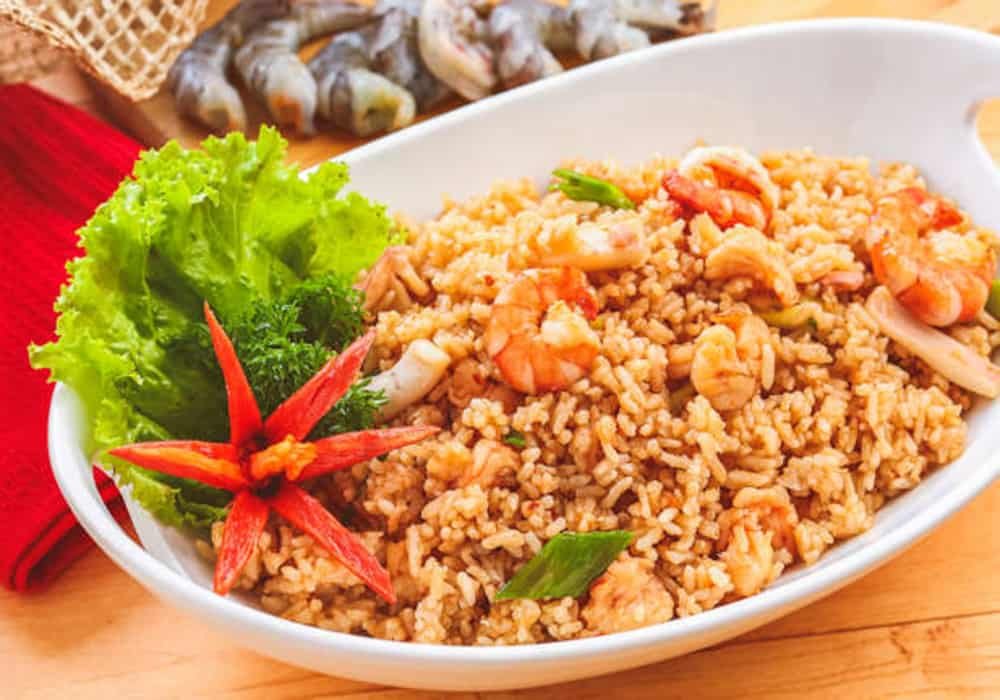
# 2 – The Sumatran Rendang
Rendang beef is a staple of the island of Sumatra and especially in its western province. This dish, found in Malaysia and the Philippines, is fragrant and tasty… but also a bit slow to prepare. This dish is made with pieces of beef marinated in various spices and simmered for about 2 hours before serving. Like many dishes in sauce, it is accompanied with white rice or ketupat, a pressed rice cake, or lemang, glutinous rice, and is best enjoyed during the festivities!
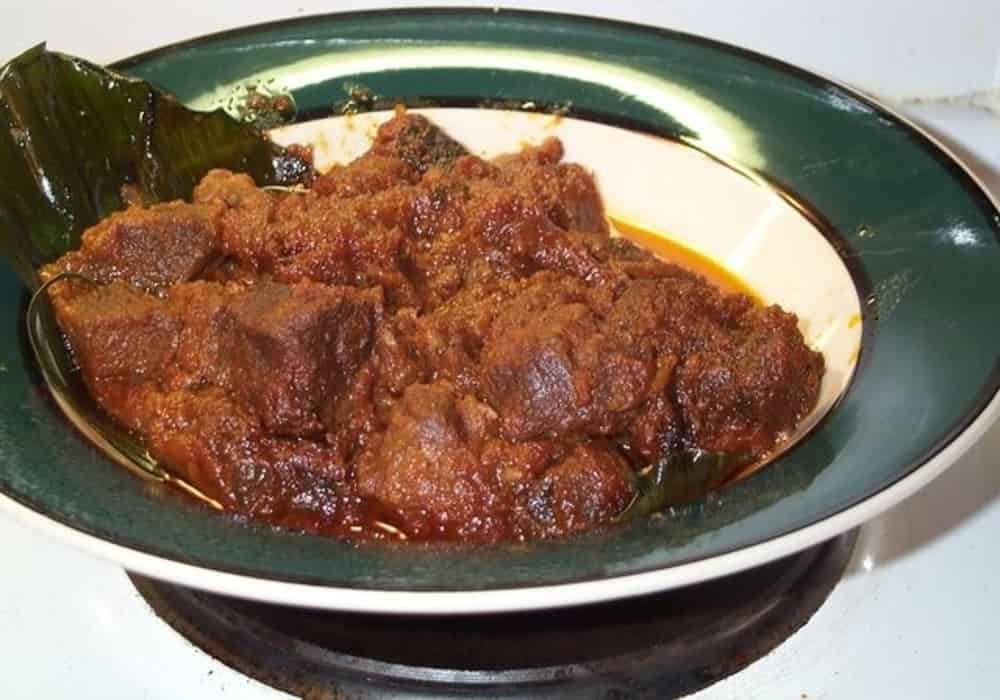
# 3 – Bali’s Babi Guling
A Bali specialty made from roast pork, Babi Guling is a delicious dish. Stuffed with garlic, ginger and many spices, the pig is roasted on a spit until obtaining a caramel-colored skin. This tasty meat is only eaten during the day, so you will be hard pressed to find it in the evening. You can enjoy this dish in Bali, the other Indonesian islands being predominantly Muslim. To eat an authentic Babi Guling, we advise you to go to a warung, a small traditional family restaurant sometimes attached to the owners’ house.
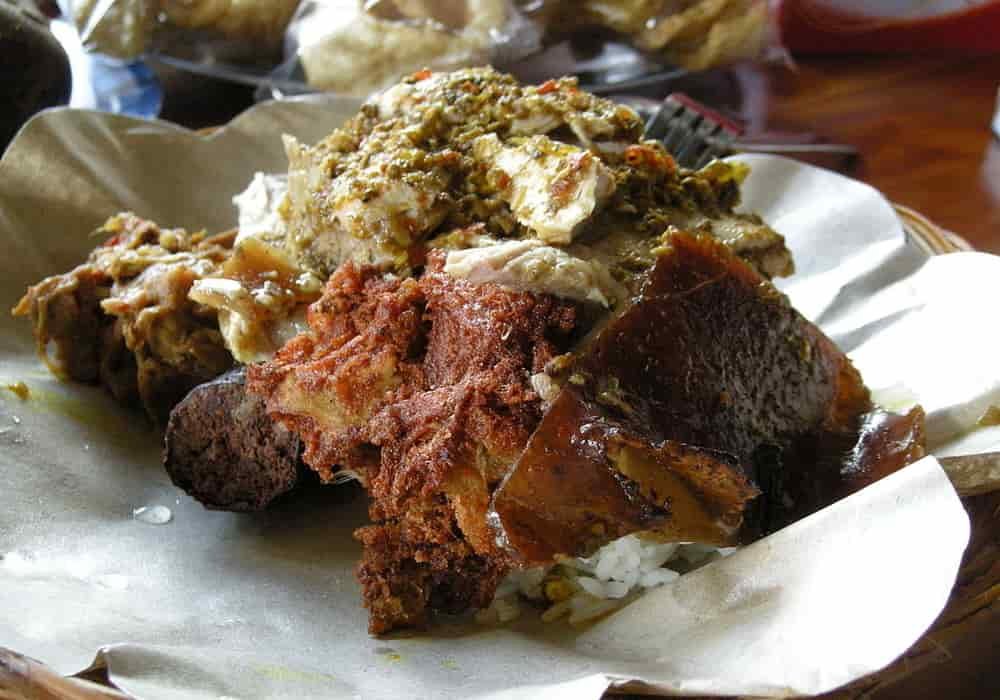
# 4 – Rica-rica of Sulawesi
This recipe is certainly quite simple but it is still delicious. Coconut rice, fried fish and above all a few spices and all you have to do is enjoy! Rica-rica uses lots of chopped or ground red and green chili peppers, bird’s eye chili, shallots, garlic, ginger, and a pinch of salt and sugar. In Indonesia, it is a popular seasoning hot and spicy to be served with various types of meat, chicken, fish or seafood grilled.
The dish can be prepared with several main ingredients. In Manado cuisine, it is usually made from a variety of fish and seafood, which are important for local cuisine, but chicken, duck and pork are also used . In addition, the Minahasa cook exotic animals following the preparation of the rich-rich, including bats, flying foxes, snakes and dogs. These varieties are not popular in other parts of the country, especially as the population of Indonesia is overwhelmingly Muslim and therefore follows thedietary rules of religion, while most minahasa are adherents of Christianity. However, rica-rica made from chicken meat, duck, fish and shrimp have become popular throughout the country.
In addition to peppers and garlic, they can also be used in the recipe nutmeg , citronella , soy sauce and coconut milk. After preparation, you can finish the dish by adding pieces of onion, vegetables, green tomatoes and pineapple.
Some versions of the dish use small doses of vinegar or lemon juice to finish and flavor.
The most popular types of dish are:
- ayam rica-rica : made with chicken and orange juice.
- bebek rica-rica : made with duck meat (bebek), usually wild duck.
- ikan rica-rica : made with varieties of carp. The dish is popular throughout Indonesia.
- sapi rica-rica : made with beef, in general cuts of front and rear muscle.
- babi rica-rica : made with pork. By the dietary rules of Islam , followers of the religion are not allowed to eat pork; therefore, this variety of rich-rich is consumed only in parts of Indonesia with a non-Muslim majority.
- paniki rica-rica : made with fruit bat meat.
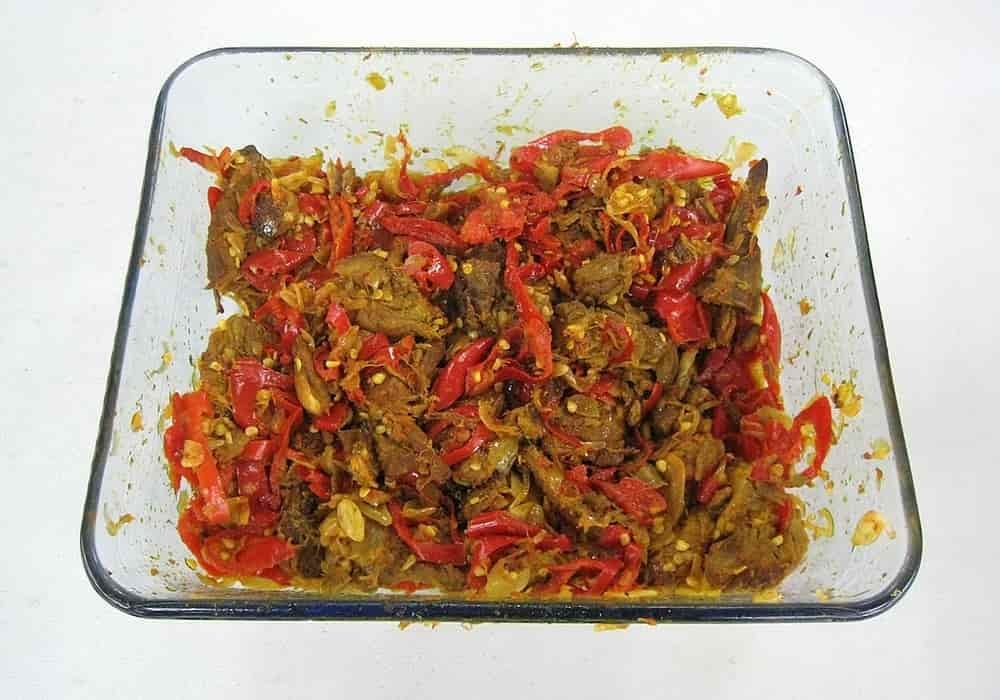
# 5 – Java’s Gado Gado
Here is an Indonesian vegetarian cuisine that will delight even the most fervent meat lovers! Gado gado is a salad in which the spicy vegetables are cooked for a few minutes to stay crunchy and then served with a peanut sauce. You can either mix the sauce with the vegetables or have them both separately. Know that gado gado, means mixture… so on your forks!
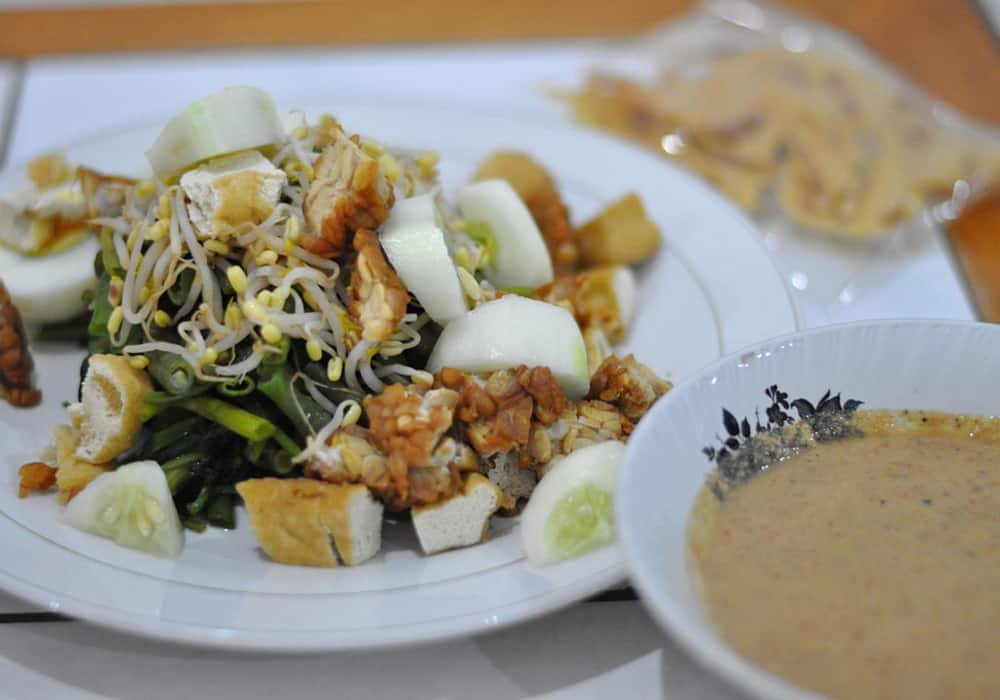
# 6 – Tumpeng tellow rice
Is an Indonesian dish, consisting of a cone of rice accompanied by vegetables, meats and various condiments1. It is traditionally presented during a selamatan, a ceremonial meal intended to celebrate an event. The rice is colored yellow with kunyit or turmeric. People on the islands of Java, Bali and Madura have the habit of making tumpeng for feasts or celebrating an important event.
The philosophical meaning of tumpeng
There is a philosophical meaning in each part of the traditional tumpeng. According to folklore in Java and Bali, the cone-shaped tumpeng is a mystical symbol of life and the ecosystem. It also symbolizes the glory of God as the Creator of nature, and the side dishes and vegetables represent life and the harmony of nature. Authentic and complete tumpeng dishes must contain at least one meat for land animals, fish for marine animals, eggs for winged animals, and vegetables that represent the food supply provided by the plant kingdom. Usually tumpeng is served with spinach because spinach is a traditional symbol of the prosperity of Javanese agrarian society.
Here are the philosophical meanings behind some tumpeng ingredients:
- Egg: eggs are served with the shell still on top. Peeling eggs before eating them symbolizes everything a person has to plan and do before becoming a good person.
- Vegetables: a pack of vegetables symbolizes a good relationship with friends and neighbors. Spinach symbolizes a safe and peaceful life; water spinach symbolizes a person who can live through hardships; green beans symbolize long life; and bean sprouts symbolize the heritage of our ancestors.
- Catfish: represents the importance of preparing for future problems. It also symbolizes humility, because catfish live at the bottom of the pond.
- Milkfish (bandeng): The abundance of milkfish bones symbolizes good luck and prosperity in the future.
- Anchovy (teri): Because they live together, anchovies symbolize a good relationship with family and neighbors.
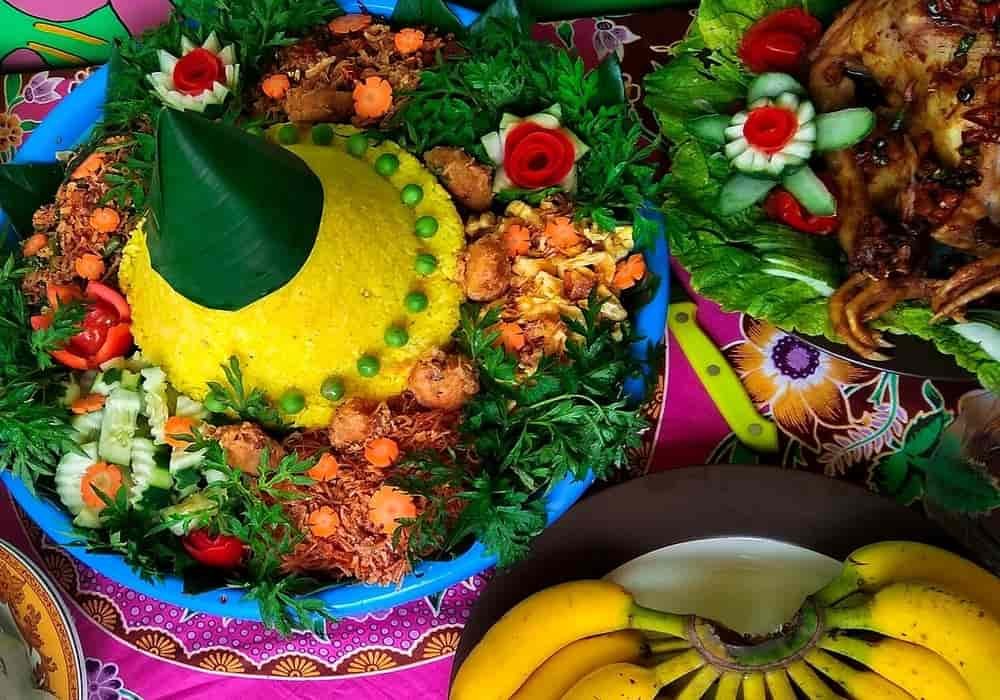
# 7 Soto
In Indonesian cuisine, soto, sroto, tauto, or coto, is a traditional soup made from broth, meat and vegetables. The country’s many traditional soups are referred to as soto, while soups of foreign and western influences are referred to as sop.
Soto is sometimes considered a “national dish”, being served from Sumatra to Papua, with many variations. This dish is also ubiquitous in Indonesia, sold in the streets to large hotels.
Introduced to Suriname by Javanese migrants, soto has also become a typical dish, where it is called saoto.
Although firmly anchored throughout the Indonesian archipelago, some historians suggest that this dish was probably influenced by Chinese cuisine. In Java it is called soto, while in Pekalongan it is called tauto (Soto tauco which refers to the fermented soybean used in soup), and coto in Makassar. In any case, it turns out that this dish, like many in Indonesian and Malay cuisine, is a mixture of local, Chinese and Indian cultures, as evidenced by the presence of bihun (rice vermicelli) for Chinese influence, or the use of turmeric for Indian influence.
Each of its provinces has developed its own recipe using local ingredients. The result is a rich variety of soto throughout Indonesia.
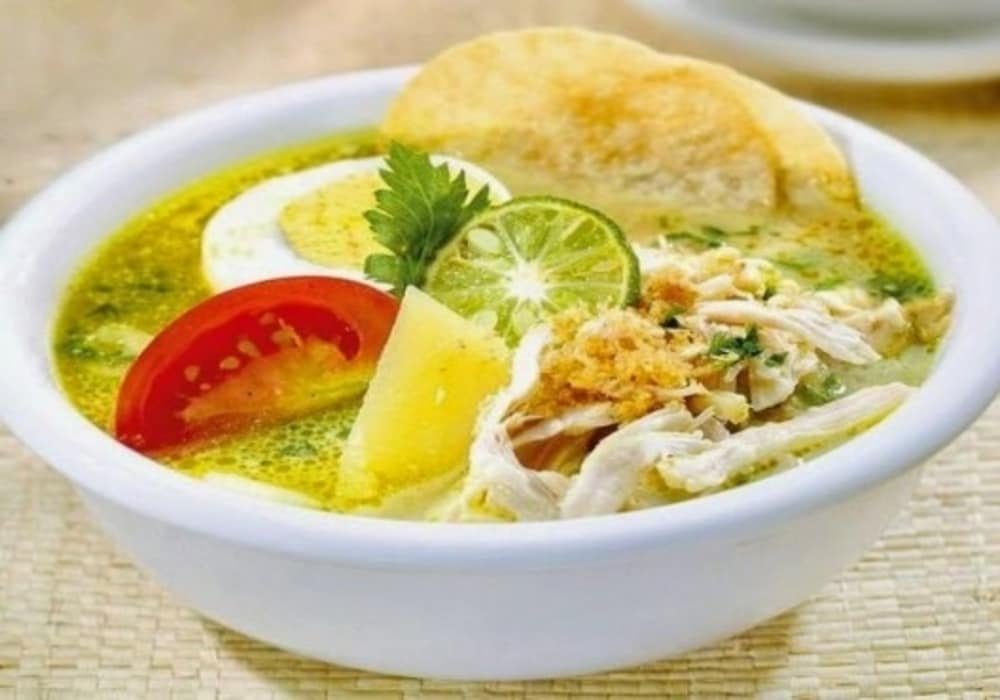
Varieties
Soto Bangkong from Semarang, chicken soup with cockles, tripe skewers, fried tempeh and meatballs.
Soto ayam served for breakfast at Savoy Homann Bidakara Hotel (Bandung).
Some soto are named after their place of origin or creation:
- soto Ambon, made from broth and chicken, flavored and colored with turmeric, ginger, galangal, garlic, lemongrass and spices. Accompanied by rice, the soup is garnished with bean sprouts, pieces of chicken, vermicelli, celery leaves, bawang goreng, fried potatoes, kecap manis, hot sauce and a small croquette of potato ;
soto Bandung, made with beef and pieces of daikon; - soto Banjar, spiced with star anise, cloves, Chinese cinnamon, lemongrass and a tangy and bitter sambal, served with potato cakes;
- soto Banyumas, sroto Banyumas or sroto Sokaraja, original by its peanut sambal, usually eaten with ketupat
soto Betawi, made from beef or beef offal, cooked in cow’s milk or coconut milk broth, with French fries and tomato; - soto Kediri, chicken and coconut milk;
- soto Kudus, made with water buffalo meat;
- soto Lamongan, a popular street food, a variation of soto Madura;
- soto Madura or soto Sulung / soto Ambengan, made with chicken, beef or offal, in a light yellow broth;
- soto Makassar or coto Makassar, made from beef and offal boiled in water used to wash the rice and roasted peanuts;
- soto Medan, chicken, pork, beef or tripe soup, with coconut milk, and served with a potato croquette. The pieces of meat are grilled before being served;
- soto Padang, beef broth, with pieces of grilled beef, bihun (rice vermicelli), and mashed and fried potato;
- soto Pekalongan (or tauto Pekalongan), spiced with tauco (fermented soybean paste);
- soto Semarang, with spicy chicken with Bancoule nut, mixed with rice, potato croquette, sate kerang (cockle skewer) or tripe and quail egg. The soto Semarang is also known under the name of soto Bangkong, named after a crossroads in Semarang;
- soto Tegal or sauto Tegal, almost identical to soto Pekalongan, spiced with tauco.
Other soto are named after their main ingredient:
- soto ayam, made with chicken in a yellow and spicy broth, with lontong, nasi empat, ketupat (compressed rice cooked in a leaf), or vermicelli. This dish can be found in Indonesia, Malaysia or Singapore;
soto babat, beef or goat tripe soup, served in a spicy yellow coconut milk, with noodles, potatoes, vegetables and rice. Present throughout Indonesia; - soto kaki (literally “soto de pied”), made from the tendons and cartilage of oxtail, served in a spicy yellow coconut milk soup, with vermicelli, potatoes, vegetables, krupuk, accompanied by rice. It is a betawi dish that can be found in Jakarta;
- soto tangkar, also a betawi specialty, made with ribs and beef brisket, cooked in a spicy coconut milk soup with turmeric, garlic, shallots, chili, pepper, galangal, Bancoule nuts, cumin, coriander and kaffir lime4;
soto mi (called mee soto in Singapore and Malaysia), a spicy yellow beef or chicken broth with noodles, found throughout the archipelago as well as in Malaysia and Singapore. Bogor, Indonesia is famous for its beef broth-based soto mi, with kikil (beef cartilage), noodles and sliced spring rolls; - soto babi is a majority Hindu pig soto from Bali.
# 8 – Nasi campur
Nasi campur, also called nasi rames, is a dish of white rice accompanied by other dishes in small portions, such as meat, vegetables, peanuts, eggs and crackers, the variation of which changes depending on the location and the food vendor.
It is a very popular main dish in Southeast Asia, and especially in Indonesia, Malaysia, Singapore, Brunei and Southern Thailand, as well as in the Netherlands because of its colonial relations with Indonesia. A similar dish, called chanpurū, exists in Okinawa.
Nasi campur is a distinctive Indonesian dish, and has produced many variations across the archipelago. No mixed rice recipe is perfectly defined, consisting only of cooked white rice surrounded by small portions of vegetables and meat, unlike tumpeng served in collective portions or rijsttafel in Dutch.
A similar dish originating from the Minangkabau is called Nasi Padang.
Balinese mixed rice
In Bali, mixed rice, called Balinese mixed rice, is in great demand by tourists. It adapts to local tastes, especially with the use of basa genep, a Balinese spice mixture used for curries and vegetable dishes. Found in Balinese versions of tuna, fried tofu, cucumber, spinach, tempeh, beef, corn and chili sauce. These are often sold on the street with banana leaves.
The majority of the island is Hindu, the Balinese version of the dish can include pork. But you can still find a halal version on the island, with chicken or egg on the side.
Javanese mixed rice
In Java, mixed rice is often called nasi padung, and there are several versions on the island.
In Yogyakarta, for example, there is ingkung rice made from whole chicken called ingkung chicken, cakes, gapit empal, jiwo skewers satay, and tumpeng rice.
Indonesian Chinese mixed rice
Another variation from the Chinese community in Indonesia is mixed Chinese rice which is an assortment of grilled meats, such as charcoal, pork sausage, or pork satay. This dish is usually served with salted chicken or vegetable soup, clear pork bone broth with fermented green mustard seeds.
The history of mixed rice
Nasi rames was invented during the Second World War by “Tante Truus” India at the Japanese internment camp in Bandung, where he was the head of the soup kitchen. Here it is served under the romusha as a plate of rice with nutritious vegetables, a little meat and chili sauce. In their own words, the real name should be: nasi remus.
After being returned to the Netherlands, he took this recipe with him and introduced it for the first time in Haarlem and then at his Oud-Indië Restaurant in The Hague. After that it became a household name, not only among the Indian community, but later also in Indonesia (known there as Nasi Campur) and in Suriname. In addition, almost all Indian and Chinese-Indian restaurants include nasi rames in their menu.
In Indian cookbooks from before the Second World War, one would search in vain for the rice rames recipe.
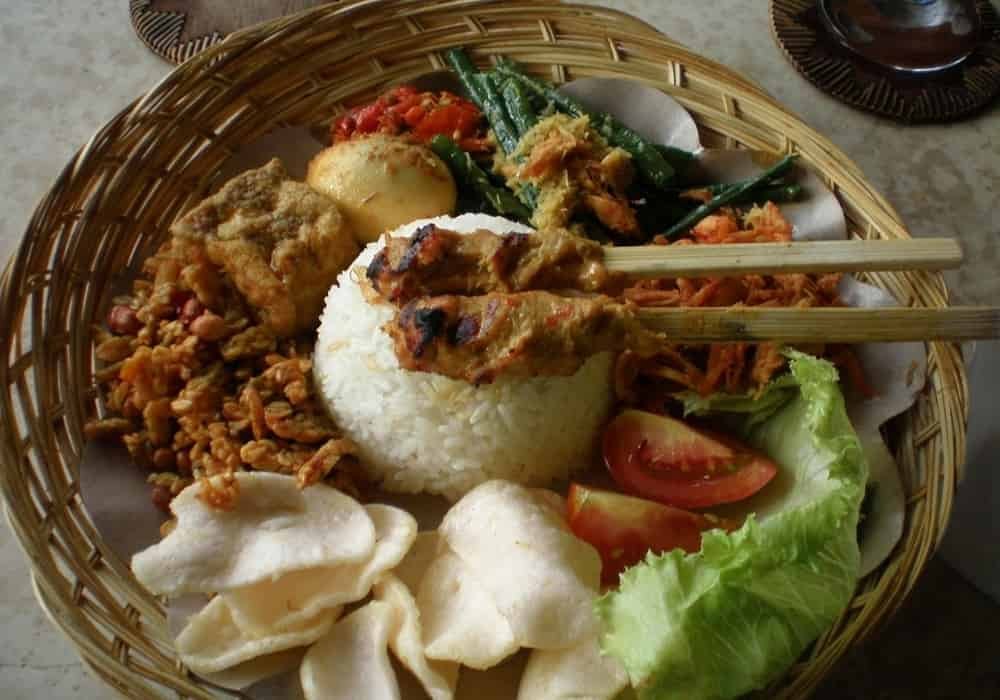
# 9 Opor Ayam (Coconut Gravy Chicken)
Opor Ayam is a flavorful dish native to Indonesia. Prepared simply with chicken, coconut milk and many spices such as cinnamon, cilantro and lemongrass, it’s a real treat. Here is an original recipe which will make travel the taste buds and the pupils of all your table. Change of scenery guaranteed!

INGREDIENTS
¼ cup coriander seeds
3 tablespoons coconut oil
10 small shallots, sliced
Kosher salt, to taste
15 garlic cloves
5 candlenuts (or 5 to 10 macadamia nuts)
2 to 3 1-inch pieces kaempferia galanga root, peeled (optional)
½ tablespoon white peppercorns
1 3-inch piece ginger, peeled and lightly smashed to loosen the fibers
1 3-inch piece galangal, peeled and lightly smashed to loosen the fibers
5 lemongrass stalks, trimmed, smashed and tied into knots
10 to 15 fresh or dried salam leaves (Indonesian bay leaves)
20 fresh makrut lime leaves
1 tomato, chopped (or 1 cup cherry tomatoes)
1 8.5-ounce can coconut milk
¾ cup chicken stock
3 pounds bone-in chicken pieces
PREPARATION
- In a dry skillet over medium-high heat, toast the coriander seeds for 2 to 3 minutes. Let cool, then grind in a spice grinder.
- In a large sauté pan, heat 2 tablespoons of the coconut oil over medium heat. Add the shallots and a generous pinch of salt and cook, stirring often, until browned, about 10 minutes. Remove shallots to a food processor and set aside. Add the garlic cloves and candlenuts to the same pan and cook, stirring constantly to prevent burning, until deep golden brown, 2 to 3 minutes. Add the garlic and candlenuts to the shallots in the food processor along with the kaempferia galanga root, white pepper and 2 tablespoons water; purée into a paste.
- Heat the remaining 1 tablespoon coconut oil in the sauté pan over medium heat and add the ginger, galangal, lemongrass, salam leaves and lime leaves, scrunching the lime leaves in your hands as you drop them into the pot. Allow to cook until the ingredients start to smell less intense and raw, stirring occasionally, 5 to 7 minutes.
- Stir the ground coriander seeds, shallot paste mixture and tomato into the pan. Reduce the heat to low and slowly stir in the coconut milk, a little at a time, to keep the sauce from breaking. When all the coconut milk is incorporated and the mixture is gently simmering, add the chicken stock. Nestle the chicken into the pan and spoon some of the sauce over the top. Cover and cook on low heat for about 40 minutes, or until the chicken is cooked through and the dish is aromatic. You may have to adjust the heat to keep the mixture at a gentle simmer. (Do not boil.) Season to taste with salt. Before serving, remove the galangal, ginger, lemongrass, salam and makrut leaves. Serve with rice.
Sources: PinterPandai, CNN, Nomadic Boys
Main photo source: Wikimedia Commons
Photo explanations: some spices for cooking Indonesian cuisine.



